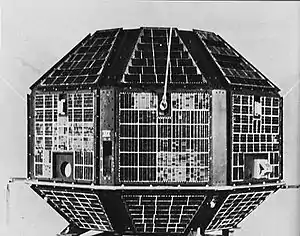| Mission type | Navigation |
|---|---|
| Operator | ISRO |
| COSPAR ID | 2016-003A[1] |
| SATCAT no. | 41241[2] |
| Website | http://www.isro.gov.in/Spacecraft/irnss-1e |
| Mission duration | 12 years |
| Spacecraft properties | |
| Spacecraft | IRNSS-1E |
| Spacecraft type | Satellite |
| Bus | I-1K |
| Manufacturer | ISRO Satellite Centre Space Applications Centre |
| Launch mass | 1,425 kilograms (3,142 lb) |
| Dry mass | 598 kilograms (1,318 lb) |
| Power | 1660 W |
| Start of mission | |
| Launch date | 09:31:00, 20 January 2016 (UTC) |
| Rocket | PSLV-C31 |
| Launch site | Satish Dhawan Second[3] |
| Contractor | ISRO |
| Orbital parameters | |
| Reference system | Geocentric |
| Regime | Geosynchronous |
| Longitude | 111.75°E[4] |
| Inclination | 28.09°[4] |
IRNSS-1E is the fifth out of seven in the Indian Regional Navigational Satellite System (IRNSS) series of satellites after IRNSS-1A, IRNSS-1B, IRNSS-1C and IRNSS-1D. It is one among the seven of the IRNSS constellation of satellites launched to provide navigational services to the region. The satellite was placed in geosynchronous orbit.[5] IRNSS-1E has been successfully launched into orbit on 20 January 2016[6][7]
Satellite
IRNSS-1E will help augmenting the satellite based navigation system of India which is currently under development. The navigational system so developed will be regional, targeted towards South Asia. The satellite will provide navigation, tracking and mapping services.[8]
The satellite will have two payloads: a navigation payload and CDMA ranging payload in addition with a laser retro-reflector. The payload generates navigation signals at L5 and S-band. design of the payload makes the IRNSS system interoperable and compatible with Global Positioning System (GPS) and Galileo.[5] The satellite is powered by two solar arrays, which generate power up to 1,660 watts, and has a designed life-time of twelve years.[6]
Launcher
Polar Satellite Launch Vehicle, in its 33rd flight (PSLV-C31), launched IRNSS-1E, the fifth satellite of the Indian Regional Navigation Satellite System (IRNSS). The launch took place from the Second Launch Pad (SLP) of Satish Dhawan Space Centre (SDSC) SHAR, Sriharikota. As in the previous four launches of IRNSS satellites, PSLV-C31 will use ‘XL’ version of PSLV. This is the eleventh time ‘XL’ configuration is being flown, earlier ten being PSLV-C11/Chandrayaan-1, PSLV-C17/GSAT-12, PSLV-C19/RISAT-1, PSLV-C22/IRNSS-1A, PSLV-C25/Mars Orbiter Spacecraft, PSLV-C24/IRNSS-1B, PSLV-C26/IRNSS-1C, PSLV-C27/IRNSS-1D, PSLV-C28/DMC-3 and PSLV-C30/ASTROSAT missions.[9]





See also
References
- ↑ NASA Space Science Data Coordinated Archive
- ↑ "IRNSS TLE". celestrak.org. Retrieved 20 November 2022.
- ↑ "PSLV-C31/IRNSS-1E - ISRO". www.isro.gov.in. Archived from the original on 14 January 2016. Retrieved 12 January 2016.
- 1 2 "Towards Self Reliance in Navigation-IRNSS". ISRO. Archived from the original on 10 March 2016.
- 1 2 "IRNSS". space.skyrocket.de. Retrieved 6 December 2014.
- 1 2 "Deccan chronicle ISRO chairman congratulates team on successful launch".
- ↑ "Successful commercial launches boost ISRO's reputation in 2015". Business Standard India. 29 December 2015. Retrieved 30 December 2015.
- ↑ "ISRO: After GSLV launch, PSLV C24 with IRNSS-1B likely in March". India TV. 5 January 2014. Retrieved 6 January 2014.
- ↑ PSLV-C31/IRNSS-1E Archived 14 January 2016 at the Wayback Machine, ISRO. Retrieved 14 January 2016

